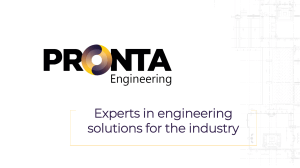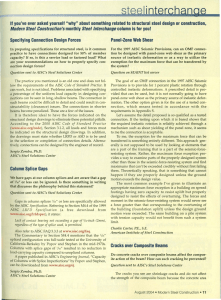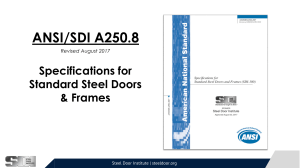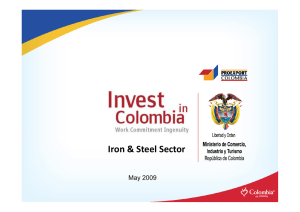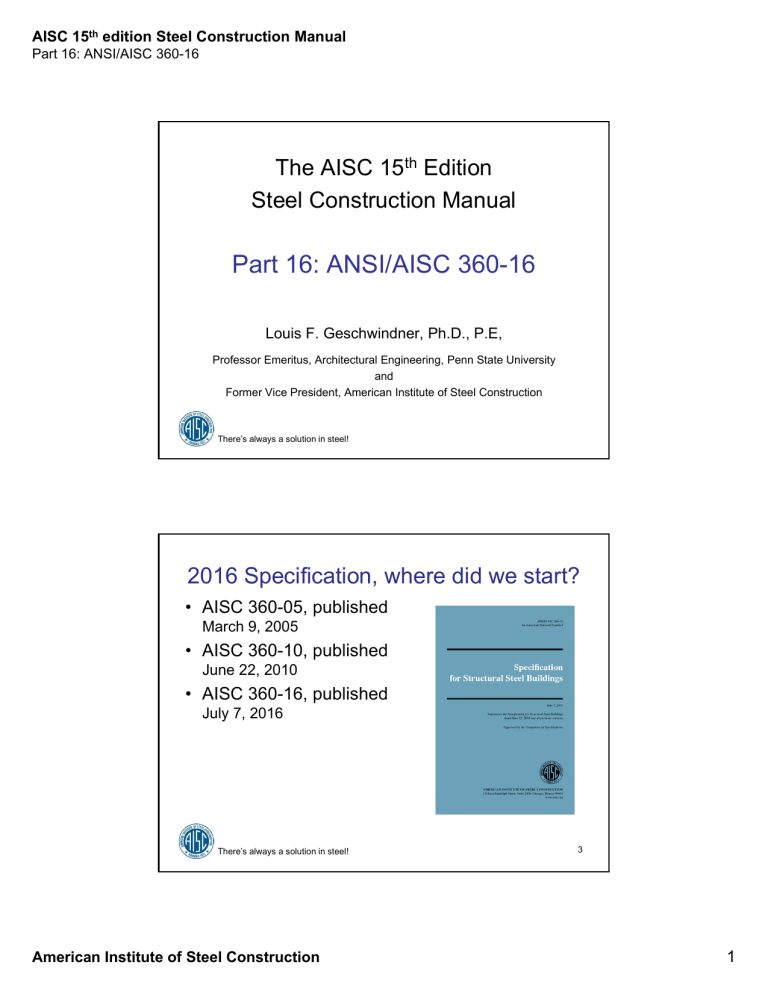
AISC 15th edition Steel Construction Manual Part 16: ANSI/AISC 360-16 The AISC 15th Edition Steel Construction Manual Part 16: ANSI/AISC 360-16 Louis F. Geschwindner, Ph.D., P.E, Professor Emeritus, Architectural Engineering, Penn State University and Former Vice President, American Institute of Steel Construction There’s always a solution in steel! 2016 Specification, where did we start? • AISC 360-05, published March 9, 2005 • AISC 360-10, published June 22, 2010 • AISC 360-16, published July 7, 2016 There’s always a solution in steel! American Institute of Steel Construction 3 1 AISC 15th edition Steel Construction Manual Part 16: ANSI/AISC 360-16 2016 Specification, what can you expect? • AISC’s continued commitment to a single specification for all types of elements. • Continued availability of provisions for LRFD and ASD (a unified specification) Ru Rn and Ra Rn • Some expansion but overall, minimal change. There’s always a solution in steel! 4 What was the goal for 2016? • To again produce a specification that reflects minimal change from previous editions. • Implement only essential changes. • Continue to coordinate with all AISC standards • Integrate with non AISC standards such as ASCE 7, IBC, and ACI. • Reference appropriate other newly approved standards. There’s always a solution in steel! American Institute of Steel Construction 5 2 AISC 15th edition Steel Construction Manual Part 16: ANSI/AISC 360-16 2016 AISC Specification • Basic organization has not changed – Still 14 Chapters, A through N – Still 8 Appendices, 1 through 8 • Within some chapters, provisions have been reorganized • Throughout there have been editorial changes that will not be discussed here There’s always a solution in steel! 6 Chapter A General Provisions • A3. Material – Tubing and pipe are now combined under Section A3.1a(b) Hollow Structural Sections (HSS) • ASTM A1065, 50 ksi welded HSS added • ASTM A1085, new HSS standard with tighter tolerances added – ASTM A1066, HSLA plate produced by thermo-mechanical controlled process added • Grades 50 to 80 There’s always a solution in steel! American Institute of Steel Construction 7 3 AISC 15th edition Steel Construction Manual Part 16: ANSI/AISC 360-16 Chapter A General Provisions • A3.3 Bolts, washers and nuts – ASTM F3125 added. It includes the former A325 and A490 type standards as grades. – Thus, ASTM A325, A490, F1852, and F2280 no longer exist as separate standards. – ASTM F3111 and F3040, 200 ksi hex head and twist-off bolts are added as Group C. These are proprietary products There’s always a solution in steel! 8 Chapter B Design Requirements • B3. Design Basis – This section has been completely reorganized – It provides the charging language for the remainder of the Specification in this new order: 1. Design by LRFD 2. Design by ASD 3. Required Strength 4. Design of Connections and Supports 5. Design of Diaphragms and Collectors There’s always a solution in steel! American Institute of Steel Construction 9 4 AISC 15th edition Steel Construction Manual Part 16: ANSI/AISC 360-16 Chapter B Design Requirements • B3. Design Basis 6. Design of Anchorages to Concrete 7. Design for Stability 8. Design for Serviceability 9. Design for Structural Integrity – new provisions 10. Design for Ponding – revised provisions 11. Design for Fatigue 12. Design for Fire Conditions 13. Design for Corrosion Effects There’s always a solution in steel! 10 Chapter B Design Requirements • B3.9 Design for Structural Integrity – When required by applicable building code (a) Column splice tensile strength (b) Beam end connection tension strength (c) Bracing connection tensile strength Strength requirements for structural integrity evaluated independently of other strength requirements. There’s always a solution in steel! American Institute of Steel Construction 11 5 AISC 15th edition Steel Construction Manual Part 16: ANSI/AISC 360-16 Chapter B Design Requirements • B3.10 Design for Ponding – Requirement regarding minimum roof slope to avoid ponding analysis is removed. – Now requires that stability for ponding be checked unless roof surface is configured to prevent the accumulation of water. – Appendix 2 is referenced and there the assumptions for use of the two approaches are defined. There’s always a solution in steel! 12 Chapter B Design Requirements • B4.2 Design Wall Thickness for HSS – Two new material specifications, ASTM A1065 and A1085. • Both permit use of nominal thickness as design wall thickness • A1085 – an HSS standard with tighter tolerances than A500 etc. • A1065 – 50 ksi plate material produced to a standard with typical plate tolerances. There’s always a solution in steel! American Institute of Steel Construction 13 6 AISC 15th edition Steel Construction Manual Part 16: ANSI/AISC 360-16 Chapter B Design Requirements • B4.2 Design Wall Thickness for HSS User Note: A pipe can be designed using the provisions of the Specification for round HSS sections as long as the pipe conforms to ASTM A53 Class B and the appropriate limitations of the Specification are used. There’s always a solution in steel! 14 Chapter C Design for Stability • C2.2 Consideration of Initial System Imperfections – System Imperfections • Imperfections in location of points of intersection of members (column out-of-plumbness) – Member Imperfections • User note now makes it clear that these are already taken into account in the column equations from Chapter E. (column out-of-straightness) There’s always a solution in steel! American Institute of Steel Construction 15 7 AISC 15th edition Steel Construction Manual Part 16: ANSI/AISC 360-16 Chapter C Design for Stability • C2.3(b) Adjustments to Stiffness – Flexural stiffness reduction factor, τb, now defined for composite members (in Chapter I) – Also redefined for members with slender elements b 4 Pr Pns 1 Pr Pns (C2-2b) • For nonslender element sections Pns Fy Ag • For slender element sections Pns Fy Ae There’s always a solution in steel! 16 Chapter C Design for Stability • K-factor – First introduced in the 1963 Specification – Set equal to 1.0 when using the direct analysis method of Chapter C (since 2005) – For 2016, KL, the effective length, has been replaced with Lc . This makes the designation of effective length simpler since in some instances, such as for torsion, the traditional definition of K is not helpful. – This has been implemented throughout the 2016 Specification There’s always a solution in steel! American Institute of Steel Construction 17 8 AISC 15th edition Steel Construction Manual Part 16: ANSI/AISC 360-16 Chapter D Tension • The only change in this chapter has to do with shear lag for longitudinally welded connections to tension members. • Case 2 no longer applies to welded connections unless they use transverse welds in combination with longitudinal welds. 18 There’s always a solution in steel! Chapter D Tension • Thus, Case 4 has been expanded to include shapes as well as plates and the shear lag factor equation revised. Case 4: Plates, angles, channels with welds at heels, tees, and W-shapes with connected elements, where the tension load is transmitted by longitudinal welds only l1 U 3l 2 x 1 3l 2 w2 l T l There’s always a solution in steel! American Institute of Steel Construction Plate or Connected Element w l1 l2 2 T l2 19 9 AISC 15th edition Steel Construction Manual Part 16: ANSI/AISC 360-16 Chapter E Compression • E4. Torsional and Flexural-Torsional Buckling of Single Angles and Members without Slender Elements – Consider what to do when twisting is not about the shear center. – Deleted the special case for double angles and tees. – Clarified that this section applies to single angles with b t 0.71 E Fy (This had been b/t > 20 in 2010) There’s always a solution in steel! 20 Chapter E Compression • E5. Single Angle Compression Members – Clarified that flexural-torsional buckling need not be considered for b t 0.71 E Fy • E6. Built-up members – Clarified need for Class A or B faying surfaces in some situations. • E7. Members with Slender Elements – Completely revised the approach and made it similar to AISI approach. There’s always a solution in steel! American Institute of Steel Construction 21 10 AISC 15th edition Steel Construction Manual Part 16: ANSI/AISC 360-16 Chapter E Compression • E7. Members with Slender Elements – Stiffened and unstiffened elements treated similarly (same effective width equation) – The critical stress is the same, regardless of element slenderness (E3-2, E3-3) – Slender element comes into play through effective area Pn Fcr Ae (E7-1) 22 There’s always a solution in steel! Chapter E Compression • E7. Members with Slender Elements – when r Fy Fcr be b There’s always a solution in steel! American Institute of Steel Construction (E7-2) 23 11 AISC 15th edition Steel Construction Manual Part 16: ANSI/AISC 360-16 Chapter E Compression • E7. Members with Slender Elements – when r Fy Fcr F F be b 1 c1 el el Fcr Fcr (E7-3) 2 Fel c2 r Fy There’s always a solution in steel! (E7-4) 24 Chapter E Compression 1 1 4c1 c2 Table E7-1 2c1 Effective Width Imperfection Adjustment Factor, c1 and c2 Factor. Case Slender Element c1 c2 (a) Stiffened elements except walls of square and rectangular HSS 0.18 1.31 (b) Walls of square and rectangular HSS 0.20 1.38 (c) All other elements 0.22 1.49 r c3 kc E Fy There are 6 distinct values for c3, found in Table B4.1a kc = 1 except for flanges of built-up I-shaped sections Round HSS still treated differently There’s always a solution in steel! American Institute of Steel Construction 25 12 AISC 15th edition Steel Construction Manual Part 16: ANSI/AISC 360-16 Chapter E Compression • E7. Members with Slender Elements Fel Fel be b 1 c1 F Fcr cr (E7-3) which, for webs of I-shaped members, ends up being E be 1.95t Fcr 0.351 E 1 b t F cr 26 There’s always a solution in steel! Chapter E Compression • E7. Members with Slender Elements be 1.95t E Fcr which for 2010 was be 1.92t There’s always a solution in steel! American Institute of Steel Construction 0.351 E 1 b t F cr SAME E f 0.34 E 1 b t f 27 13 AISC 15th edition Steel Construction Manual Part 16: ANSI/AISC 360-16 Chapter E Compression • E7. Members with Slender Elements 2010 Q Ae Ag QFy Fcr 0.658 Fe Pn Fcr Ag Ae Ag (b be )t 2016 Fy Fcr 0.658 Fe Pn Fcr Ae QFy Fy 28 There’s always a solution in steel! Chapter E Compression Built-up I-shape with Slender Flange, Fy = 50 ksi 2500 b t f 24.0 0.64 kc E Fy 12.96 2000 Flanges 24 in. x 0.5 in. Web 24 in. x 0.75 in. Pn, kips 1500 2010 Pn 2016 Pn 1000 w/o slender elements For 2010, Q =0 .641 500 0 0 20 40 60 Effective Length, Lc, (KL) There’s always a solution in steel! American Institute of Steel Construction 80 100 For 2015, worst case Ae/Ag = 0.904 29 14 AISC 15th edition Steel Construction Manual Part 16: ANSI/AISC 360-16 Chapter F Flexure • F1. General Provisions – Clarify Cb for cantilevers • F4. and F5. Noncompact and slender webs – Revised effective radius of gyration for LTB • F7. HSS and Box Sections – Clarified here and throughout that box sections were doubly symmetric and treated like rectangular HSS – For box sections added slender web and lateraltorsional buckling There’s always a solution in steel! 30 Chapter F Flexure • F9. Tees and Double Angles – Revised LTB provisions – Revised stem local buckling – Cleaned-up and reorganized section • F10. Single Angles – Reduced conservatism for LTB by making a more realistic assumption for b/t • F13.1 Holes in tension flanges – Clarified use of minimum section modulus There’s always a solution in steel! American Institute of Steel Construction 31 15 AISC 15th edition Steel Construction Manual Part 16: ANSI/AISC 360-16 Chapter F Flexure • F9. Tees and Double Angles – LTB 2010 2016 L p Lb Lr Lp and Lr not used M n M cr EI y GJ Lb B d I B 2.3 y Lb J 1 B 2 L Lp Mn M p M p M y b Lr Lp Lb Lr Same equations M n M cr 1.95 E I y J B 1 B2 Lb Stems and web legs in compression Tees and double angles treated a bit differently 32 There’s always a solution in steel! Chapter F Flexure • F9. Tees and Double Angles – Stem LB 2010 0.84 2016 E d E 1.03 Fy tw Fy d Fcr 2.55 1.84 tw 0.84 Fy Fy E d E 1.03 tw Fy Fcr 0.69 E d tw 2 There’s always a solution in steel! American Institute of Steel Construction E d E 1.52 Fy tw Fy d Fcr 1.43 0.515 t w Fy Fy E d E 1.52 tw Fy Fcr 1.52 E 2 d tw Double angles treated like 2 single angles 33 16 AISC 15th edition Steel Construction Manual Part 16: ANSI/AISC 360-16 Chapter F Flexure Stem Local Buckling of Tees 60.0 Critical Stress, Fcr 50.0 40.0 30.0 2010 2016 20.0 10.0 0.0 0 10 20 30 40 50 60 Stem Slenderness, d/tw 70 80 90 There’s always a solution in steel! 34 Chapter G Shear • G2. I-shaped Members and Channels – G2.1 Shear Strength of Webs without Tension Field Action • Increased strength by accounting for some postbuckling strength of web – G2.2 Shear Strength of Interior Web Panels with a h 3 Considering Tension Field Action • Expanded tension field action beyond the limits found in 2010. There’s always a solution in steel! American Institute of Steel Construction 35 17 AISC 15th edition Steel Construction Manual Part 16: ANSI/AISC 360-16 Chapter G Shear Web Shear Coefficient without TFA 2010 vs. 2016 Vn 0.6 Fy AwCv1 1.200 For h tw 1.10 kv E Fy 1.000 Cv1 Vn/0.6FyAw 0.800 1.10 kv E Fy h tw , a 3 h Cv (2010) (Kv=5) 0.600 Cv1 (2016)(kv=5.34) Cv (2016)(Kv=5.34) 0.400 0.200 0.000 0 50 100 150 200 250 300 h/tw 36 There’s always a solution in steel! Chapter G Shear Vn 0.6 Fy AwCv1 Web Shear Coefficient without TFA as a function of a/h Cv1 1.200 kv 5 1.000 h tw 5 a h 2 5.34 when a / h 3.0 0.800 Vn/0.6FyAw 1.10 kv E Fy Cv1(3.0) 0.600 Cv1(2.0) Cv1(1.0) 0.400 Cv1(0.5) For stiffened panels with a/h = ( ) 0.200 0.000 0 50 100 150 200 250 300 h/tw There’s always a solution in steel! American Institute of Steel Construction 37 18 AISC 15th edition Steel Construction Manual Part 16: ANSI/AISC 360-16 Chapter G Shear • Tension field action is extended beyond previous limits TFA - G2.2(b)(2) 2010 not permitted in end panels TFA - G2.2(b)(1) 2016 permitted interior panels with 2016 permitted interior panels with a h 3 or 260 h t w a h3 a h3 2 Aw A fc 2 Aft 2.5 2 Aw Afc Aft 2.5 2 Aw h b fc and h b ft 6 h b fc or h b ft 6 1 Cv 2 Vn 0.6 Fy Aw Cv 2 2 1.15 1 a h fc Aft 2.5 h b fc or h b ft 6 1 Cv 2 Vn 0.6 Fy Aw Cv 2 2 1.15 a h 1 a h There’s always a solution in steel! A The 2010 Cv 38 Chapter G Shear • G2.3 Transverse Stiffeners – w/ and w/o TFA requirements combined in to one section – w/o TFA stiffeners must be stiffer than for Same as 2010 Provisions. 2010 2.5 b t st 0.56 E Fyst I st I st 2 I st1 I st 2 w Shear strength calculated with 2016 post-buckling or TFA provisions. There’s always a solution in steel! American Institute of Steel Construction 2 bp tw3 0.5bp tw3 I st 2 2 a h 1.5 I st1 Fyw h 41.3 st 40 E V Vc 2 w r Vc1 Vc 2 For full post buckling strength Shear strength calculated with 2010 Provisions. 39 19 AISC 15th edition Steel Construction Manual Part 16: ANSI/AISC 360-16 Chapter H Interaction • Throughout chapter clarified that required strengths were to be determined in accordance with Chapter C. – H1. Doubly and Singly Symmetric Members • Deleted limit 0.1 I yc I y 0.9 – H1.3 Single Axis Flexure • Clarified that the flexural strength to be used for inplane instability was based only on the limit state of yielding. There’s always a solution in steel! 40 Chapter I Composite • I1.2 Nominal strength determination – Added two new approaches • (c) Elastic Stress Distribution • (d) Effective Stress-Strain Method • I1.3 Material limitations – Increased maximum reinforcing steel to 80 ksi – Increased maximum structural steel to 75 ksi (to be used in calculations) There’s always a solution in steel! American Institute of Steel Construction 41 20 AISC 15th edition Steel Construction Manual Part 16: ANSI/AISC 360-16 Chapter I Composite • I1.5 Stiffness for Calculation of Required Strengths – This section is added to coordinate with Chapter C – For flexure; EI eff Es I s Es I sr C1 Ec I c (encased) – For flexure; b 0.8 – For axial; summation of axial stiffnesses 42 There’s always a solution in steel! Chapter I Composite • I2 Axial Force • I2 Axial Force – Effective stiffness of encased composite section increased – Effective stiffness of filled composite section For 2010 this ratio did not include Asr EI eff Es I s Es I sr C1 Ec I c EI eff Es I s Es I sr C3 Ec I c A Asr C1 0.25 3 s A g A Asr C3 0.45 3 s A g 0.7 0.1 C1 0.3 2010 limits 0.9 0.6 C3 0.9 May now use all of reinforcing steel stiffness, was 0.5 There’s always a solution in steel! American Institute of Steel Construction 43 21 AISC 15th edition Steel Construction Manual Part 16: ANSI/AISC 360-16 Chapter I Composite • I3. Flexure – I3.2d Load transfer between steel beam and concrete slab • The effect of ductility (slip capacity) of the shear connection at the interface of the concrete slab and steel beam shall be considered. The intent is to limit the minimum composite action used. Currently the AISC Manual tables go from full composite action to 25% composite action. The Commentary provides guidance. There’s always a solution in steel! 44 Chapter J Connections • J1. General Provisions – J1.6. For heavy sections, removed magnetic particle and dye penetrant methods of assessment for access holes – J1.8. Clarified/expanded use of bolts in combination with welds – J1.10. Deleted. Removed requirement for use of pretensioned bolts in buildings over 125 ft. and moved remaining requirements to J3.1 There’s always a solution in steel! American Institute of Steel Construction 45 22 AISC 15th edition Steel Construction Manual Part 16: ANSI/AISC 360-16 Chapter J Connections • J2. Welds – J2.1a. PJP groove welds permitted/requirements when filled less than full depth – J2.2b. Fillet weld terminations now presented as a performance requirement – J.2.4. Strength. Must account for strain compatibility. The Instantaneous Center of Rotation method is removed and placed in a User Note and the Manual There’s always a solution in steel! 46 Chapter J Connections • J3. Bolts – J3.1. High-Strength Bolts • Group A – ASTM F3125/F3125M Grades A325, A325M, F1852, and ASTM A354 Grade BC (120 ksi) • Group B – ASTM F3125/F3125M Grades A490, A490M, F2280, and ASTM A354 Grade BD (150 ksi) • Group C – ASTM F3043 and F3111 (200 ksi) • A449 was removed from Group A so strength is now determined as for threaded parts. There’s always a solution in steel! American Institute of Steel Construction 47 23 AISC 15th edition Steel Construction Manual Part 16: ANSI/AISC 360-16 Chapter J Connections • J3. Bolts – J3.1. High-Strength Bolts • Designation of when to use which type of installation; – J3.1(a) snug-tight Two cases – J3.1(b) pre-tensioned Three cases – J3.1(c)slip critical Two cases This change is more for clarity than for actually changing anything. There’s always a solution in steel! 48 Chapter J Connections • J3.2 Holes – For bolts 1 in. diameter and larger the standard hole size is now 1/8 in. larger than the bolt to address fit-up issues. – Specific requirements for washers removed and reference made to RCSC requirements. • J3.3 Minimum Spacing – Clear distance not less than d There’s always a solution in steel! American Institute of Steel Construction 49 24 AISC 15th edition Steel Construction Manual Part 16: ANSI/AISC 360-16 Chapter J Connections • J3.10 Bearing and Tearout Strength – The format of these equations has been changed to present bearing and tearout in separate subsections. – The strength equations are unchanged – The process • Determine bearing strength of each bolt • Determine tearout strength of each bolt There’s always a solution in steel! 50 Chapter J Connections • J4.1 Affected elements in tension – Special requirement for bolted splice plates removed since the resistance/safety factor (unchanged) already accounts for this Ae An 0.85 Ag There’s always a solution in steel! American Institute of Steel Construction 51 25 AISC 15th edition Steel Construction Manual Part 16: ANSI/AISC 360-16 Chapter J Connections • J5.2 Fillers – This section now defined as specifically for bearing type connections – Fillers may now be welded – Fillers in slip critical connections and turn of the nut method removed as a special requirement. Fillers > 0.25 in. 52 There’s always a solution in steel! Chapter J Connections • J10.3 Web crippling – The variable Qf is introduced to permit material from Chapter K for HSS to be moved here. 1.5 l t Rn 0.80tw2 1 3 b w d t f EF t yw f Qf tw (J10-4) • J10.5 Web compression buckling – Added Qf Rn 24tw3 EFyw There’s always a solution in steel! American Institute of Steel Construction h Qf (J10-8) 53 26 AISC 15th edition Steel Construction Manual Part 16: ANSI/AISC 360-16 Chapter J Connections • J10.6 Web panel zone shear – Variable Pr changed to αPr for consistency with other parts of the Specification considering LRFD and ASD. – Clarified that consideration of panel zone deformation means inelastic panel zone deformation • J10.10 Transverse Forces on Plates – Section added with general provisions and a user note There’s always a solution in steel! 54 Chapter K HSS Connections • Design of HSS Connections – Clarifies that box sections must be of uniform thickness to use this chapter – Clarifies that you can design connections that do not meet the limitations, just can not use these specific provisions – As many provisions as appropriate now simply refer to Chapter J There’s always a solution in steel! American Institute of Steel Construction 55 27 AISC 15th edition Steel Construction Manual Part 16: ANSI/AISC 360-16 Remaining Chapters • Chapter L: Serviceability – Limit states now specifically referenced – Camber deleted since it is not a serviceability limit state • Chapter M: Fabrication and Erection – Only editorial and clarifications There’s always a solution in steel! 56 Remaining Chapters • Chapter N: Quality – Steel Deck requirements now point to SDI – Welds • Access holes in heavy shapes • Unauthorized welds – N5.5 added establishment of ultrasonic testing rejection rate – N5.7 added for galvanized main members – N6 Composite deleted since reference SDI There’s always a solution in steel! American Institute of Steel Construction 57 28 AISC 15th edition Steel Construction Manual Part 16: ANSI/AISC 360-16 Appendix 1 • Title changed from Design by Inelastic Analysis to Design by Advanced Analysis • Added a new section for design by elastic analysis – Includes direct modeling of system and member imperfections. – Essentially results in designing with Lc=0. Pn Fy Ag or Pn Fy Ae There’s always a solution in steel! 58 Appendix 2 • Design for Ponding – Clearly identify the assumptions which must be met for use of the appendix method. • Flat roofs with rectangular bays where beams are uniformly spaced and girders are considered to be uniformly loaded. – Clarified load determination for use of Appendix 2.2 Improved Design for Ponding There’s always a solution in steel! American Institute of Steel Construction 59 29 AISC 15th edition Steel Construction Manual Part 16: ANSI/AISC 360-16 Appendix 3 • Fatigue – Simplifies some equations, adds new fatigue cases and revises figures – Changed the requirement to check fatigue to a positive; check when cycles exceed 20,000 – Many changes throughout There’s always a solution in steel! 60 Appendix 4 • Fire – Clarify that design by analysis is acceptable under the alternative methods provisions of the applicable building code – Added information on bolt strength – Added reference to newly published standards, NFPA 557 and SFPE S.01 – Added composite beam strength retention factors – Added provisions for shear and combined forces and torsion There’s always a solution in steel! American Institute of Steel Construction 61 30 AISC 15th edition Steel Construction Manual Part 16: ANSI/AISC 360-16 Appendix 5 • Existing Structures – Removed limit to gravity loading only – Gravity loading limit retained for load testing – Added the requirement to record deformations once the loading has been removed There’s always a solution in steel! 62 Appendix 6 • Stability Bracing – Name Changes: • Nodal bracing changed to Point bracing • Relative bracing changed to Panel bracing – Clarify the “In lieu of this appendix” requirements – Slight revision in required strength values – Beam-Column bracing provisions expanded for doubly and singly symmetric members There’s always a solution in steel! American Institute of Steel Construction 63 31 AISC 15th edition Steel Construction Manual Part 16: ANSI/AISC 360-16 Appendix 7 • Alternative Methods for Stability – 7.3 First-Order analysis • Change the limits of applicability to account for inelasticity in a member with slender elements, Pr 0.5 Py becomes Pr 0.5 Pns • Now permits the use of effective length less than actual length between brace points (K<1) There’s always a solution in steel! 64 Appendix 8 • Approximate Second-Order Analysis – Deleted the phrase “as an alternative to a rigorous second-order analysis” from the preamble. – Recognized as an approximate procedure. • Has no impact on use of the method since this is simply a method, not rigorous, not non-rigorous. • Appendix 8 is referenced in Chapter C as an acceptable method. There’s always a solution in steel! American Institute of Steel Construction 65 32 AISC 15th edition Steel Construction Manual Part 16: ANSI/AISC 360-16 Conclusion • AISC Board approved June 16, 2016 • ANSI approved July 7, 2016 • AISC 360-16 issued in print in January 2017. • 15th Edition Steel Construction Manual available Summer 2017. There’s always a solution in steel! 66 Thank You American Institute of Steel Construction 130 East Randolph St., Suite 2000 Chicago, IL 60601 There’s always a solution in steel! American Institute of Steel Construction 67 33
